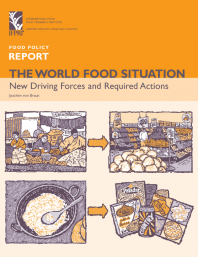
The World Food Situation: New Driving Forces and Required Actions

The World Food Equation, Rewritten (excerpt)
The world food situation is currently being rapidly redefined by new driving forces. Income growth, climate change, high energy prices, globalization, and urbanization are transforming food consumption, production, and markets.The influence of the private sector in the world food system, especially the leverage of food retailers, is also rapidly increasing. Changes in food availability, rising commodity prices, and new producer–consumer linkages have crucial implications for the livelihoods of poor and food-insecure people. Analyzing and interpreting recent trends and emerging challenges in the world food situation is essential in order to provide policymakers with the necessary information to mobilize adequate responses at the local, national, regional, and international levels. It is also critical for helping to appropriately adjust research agendas in agriculture, nutrition, and health. Not surprisingly, renewed global attention is being given to the role of agriculture and food in development policy, as can be seen from the World Bank’s World Development Report, accelerated public action in African agriculture under the New Partnership for Africa’s Development (NEPAD), and the Asian Development Bank’s recent initiatives for more investment in agriculture, to name just a few examples.
- Issues:
- Demography, Urbanization and Migration, Natural Resources
- Region:
- Global
- Year Published:
- 2007
- Author:
- Joachim von Braun
- Institution:
- International Food Policy Research Institute (IFPRI)

